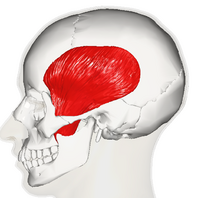Temporalis: Difference between revisions
No edit summary |
No edit summary |
||
| Line 10: | Line 10: | ||
== Description == | == Description == | ||
[[File:Temporal_muscle_lateral_view.png|right|frameless|198x198px]] | [[File:Temporal_muscle_lateral_view.png|right|frameless|198x198px]] | ||
The temporalis muscle is one of the four primary [[Muscles of Mastication|muscles of mastication]]. It is a fan-shaped muscle with anterior fibres that have a vertical orientation, mid fibres have an oblique orientation, and posterior fibres have a more of horizontal orientation. <ref>Basit H, Tariq MA, Siccardi MA. [https://www.ncbi.nlm.nih.gov/books/NBK541027/ Anatomy, head and neck, mastication muscles].</ref> | The temporalis muscle is one of the four primary [[Muscles of Mastication|muscles of mastication]] (chewing of food). It is a fan-shaped muscle with anterior fibres that have a vertical orientation, mid fibres have an oblique orientation, and posterior fibres have a more of horizontal orientation. <ref name=":0">Basit H, Tariq MA, Siccardi MA. [https://www.ncbi.nlm.nih.gov/books/NBK541027/ Anatomy, head and neck, mastication muscles].</ref> | ||
=== Origin === | === Origin === | ||
| Line 25: | Line 25: | ||
=== Artery === | === Artery === | ||
Maxillary artery which is a branch of the external carotid artery. | |||
== Function == | == Function == | ||
| Line 32: | Line 33: | ||
== Clinical relevance == | == Clinical relevance == | ||
Temporalis is used for:<ref>Yu SK, Kim TH, Yang KY, Bae CJ, Kim HJ. [https://www.ncbi.nlm.nih.gov/pmc/articles/PMC8493017/#:~:text=The%20temporalis%20muscle%20is%20usually,site%20of%20the%20coronoid%20process. Morphology of the temporalis muscle focusing on the tendinous attachment onto the coronoid process.] Anatomy & Cell Biology. 2021 Sep 1;54(3):308-14.</ref> | Masticatory muscle disorders to take note of:<ref name=":0" /> | ||
* '''<u>Myofascial pain and dysfunction.</u>''' Most common etiologies myofascial pain and dysfunction of masticatory muscles: | |||
** Nocturnal bruxism | |||
** Habitual clenching of the mouth | |||
** Whiplash injuries during a trauma | |||
* <u>'''Temporomandibular joint (TMJ) dysfunction'''</u> | |||
** It can be caused by an imbalance of forces within the muscles of mastication. | |||
** Nocturnal bruxism is a common cause of TMJ dysfunction. | |||
* '''<u>Trismus aka Muscle spasm of the muscles of mastication</u>''' | |||
** It can be a symptom of tumor or infection. An infection like tetanus may present with "lockjaw" or trismus. | |||
* Other infections or inflammation of the muscles may present as: | |||
** myositis | |||
** pain during the movement of the jaw. | |||
Temporalis muscle is used for:<ref>Yu SK, Kim TH, Yang KY, Bae CJ, Kim HJ. [https://www.ncbi.nlm.nih.gov/pmc/articles/PMC8493017/#:~:text=The%20temporalis%20muscle%20is%20usually,site%20of%20the%20coronoid%20process. Morphology of the temporalis muscle focusing on the tendinous attachment onto the coronoid process.] Anatomy & Cell Biology. 2021 Sep 1;54(3):308-14.</ref> | |||
* Direct temporalis tendon injections | * Direct temporalis tendon injections | ||
Revision as of 08:19, 11 January 2024
This article or area is currently under construction and may only be partially complete. Please come back soon to see the finished work! (11/01/2024)
Original Editor - Carina Therese Magtibay
Top Contributors - Carina Therese Magtibay
Description[edit | edit source]
The temporalis muscle is one of the four primary muscles of mastication (chewing of food). It is a fan-shaped muscle with anterior fibres that have a vertical orientation, mid fibres have an oblique orientation, and posterior fibres have a more of horizontal orientation. [1]
Origin[edit | edit source]
Temporal bone, specifically the floor of the temporal fossa
Insertion[edit | edit source]
Coronoid process of the mandible
Nerve[edit | edit source]
- Central part: deep temporal nerves of the mandibular nerve
- Anterior part: branches of the buccal nerve
- Posterior part: branches of the masseteric nerve
Artery[edit | edit source]
Maxillary artery which is a branch of the external carotid artery.
Function[edit | edit source]
- Anterior fibres: Elevates mandible
- Posterior fibres: Retracts the mandible
Clinical relevance[edit | edit source]
Masticatory muscle disorders to take note of:[1]
- Myofascial pain and dysfunction. Most common etiologies myofascial pain and dysfunction of masticatory muscles:
- Nocturnal bruxism
- Habitual clenching of the mouth
- Whiplash injuries during a trauma
- Temporomandibular joint (TMJ) dysfunction
- It can be caused by an imbalance of forces within the muscles of mastication.
- Nocturnal bruxism is a common cause of TMJ dysfunction.
- Trismus aka Muscle spasm of the muscles of mastication
- It can be a symptom of tumor or infection. An infection like tetanus may present with "lockjaw" or trismus.
- Other infections or inflammation of the muscles may present as:
- myositis
- pain during the movement of the jaw.
Temporalis muscle is used for:[2]
- Direct temporalis tendon injections
- As a landmark for inferior alveolar nerve block anesthesia, third molar extraction, and determining posterior denture flange
- Temporalis tendon transfers in plastic surgery
Assessment[edit | edit source]
Treatment[edit | edit source]
Resources[edit | edit source]
- ↑ 1.0 1.1 Basit H, Tariq MA, Siccardi MA. Anatomy, head and neck, mastication muscles.
- ↑ Yu SK, Kim TH, Yang KY, Bae CJ, Kim HJ. Morphology of the temporalis muscle focusing on the tendinous attachment onto the coronoid process. Anatomy & Cell Biology. 2021 Sep 1;54(3):308-14.







